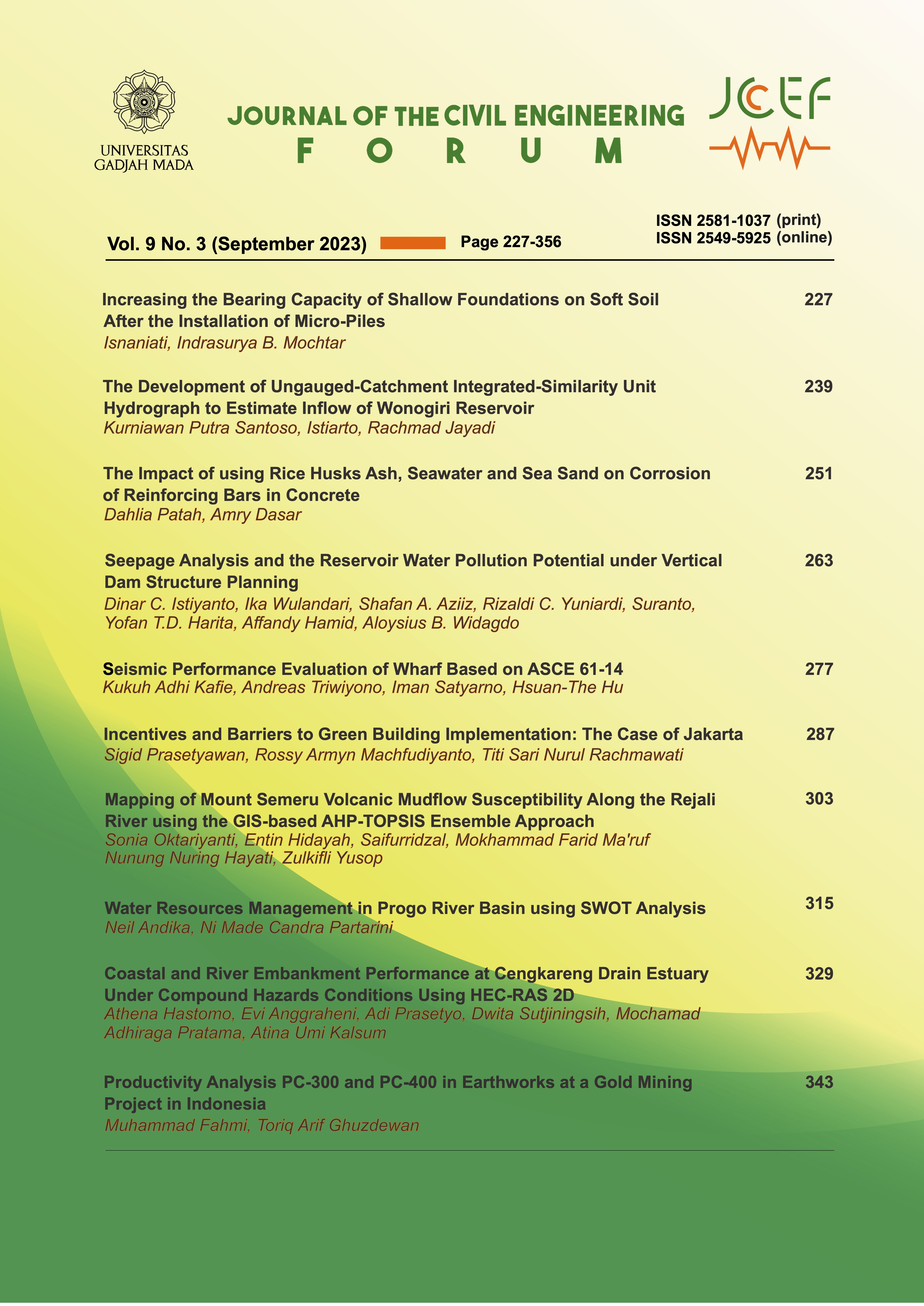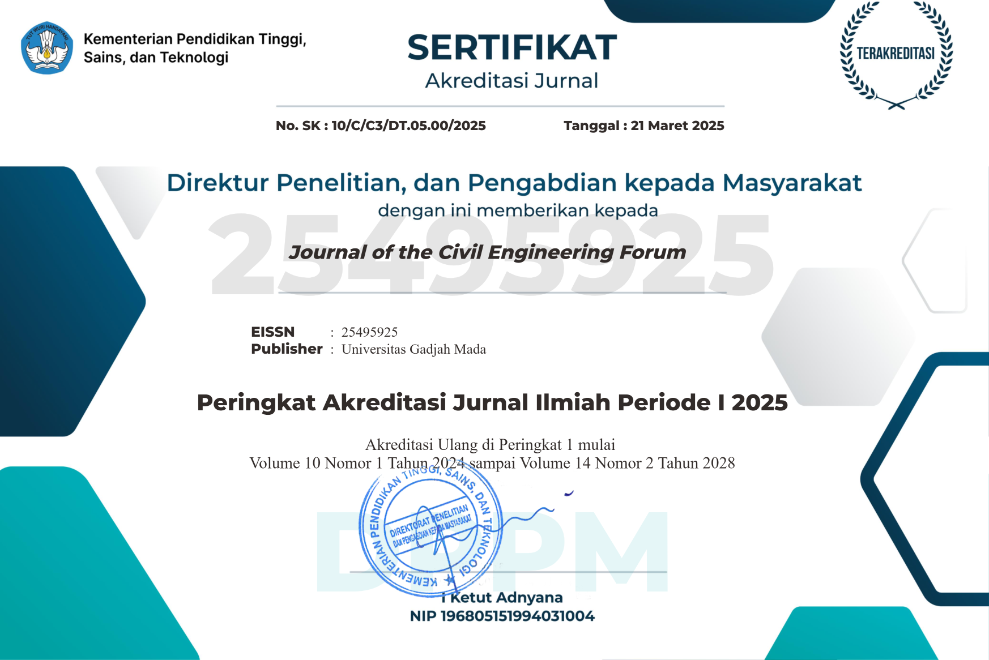The Development of Ungauged-Catchment Integrated-Similarity Unit Hydrograph to Estimate Inflow of Wonogiri Reservoir
Abstract
The Wonogiri Reservoir is a multipurpose reservoir at the Upper Bengawan Solo Watershed, primarily designed to serve as a flood control system. However, there is no accurate estimation of the inflow into the reservoir due to the limited availability of hydrological stations. Observations showed only four out of ten unit hydrographs of the Wonogiri Reservoir watershed. Therefore, this study was conducted to apply an integrated similarity-based approach for designing unit hydrographs in ungauged catchments. The process involved evaluating the integrated similarity between pairs of gauged-ungauged catchments using hydrologic and physical property parameters. This led to the selection of the donor or gauged catchment with the highest similarity score to develop the unit hydrograph for the ungauged catchments. The developed UHs were further applied to estimate the reservoir inflow for the December 25, 2007, flood event. The results showed that the computed peak discharge was 10.9% lower than a previous study. Subsequently, the HEC-HMS simulation model was used to project the updated design flood hydrographs to the reservoir. The design rainfall was derived from automatic rainfall recorder (ARR) and PERSIANN satellite-based data. The ARR data showed that the extreme rainfall duration was 5 hours while satellite data indicated 6 hours. The application of the ARR 5-hour duration to the updated flood hydrographs led to a peak discharge of 5123 m3 s-1, 7041 m3 s-1, and 10,370 m3 s-1 for the 60-year, 500-year, and PMF floods respectively in line with the flood design criteria of Wonogiri Reservoir. These estimates were observed to be significantly higher than the 1982 design floods which were 4000 m3 s-1, 5100 m3 s-1, and 9600 m3 s-1 respectively. This updated flood control design was important to renew the operation rule of the Wonogiri reservoir during flood periods.
References
Bunganaen, W., Frans, J., Seran, Y., Legono, D. and Krisnayanti, D. (2021), ‘Rainfall-runoff simulation using hec-hms model in the benanain watershed, timor island’, Journal of the Civil Engineering Forum 7(3), 359.
Chow, V., Maidment, D. and Mays, L. (1988), Applied Hydrology, Mc. Graw-Hill Book Company, New York.
Direktorat Jenderal Pengairan Departemen Pekerjaan Umum (1999), Panduan Perencanaan SID Bendungan Urugan, Jakarta.
FAO and IIASA and ISRIC and ISS-CAS and JRC (2012), ‘Harmonized world soil database (version1.2)’. URL: https://www.fao.org/soils-portal/datahub/soil-maps-and-databases/harmonized-worldsoil-database-v12/en/
Geospatial Information Agency of Indonesia (2018), ‘Demnas’. URL: https://tanahair.indonesia.go.id/demnas//demnas
Huff, F. (1990), ‘Time distributions of heavy rainstorms in illinois’, Illinois .
Jayadi, R., Istiarto and Pradipta, A. (2018), ‘Impactof sedimentation counter measure on the performance of flood control: A case study of wonogiri reservoir’, Applied Mechanics and Materials 881, 78–85.
Kamran, M. and Rajapakse, R. (2018), ‘Effect of watershed subdivision and antecedent moisture condition on hec-hms model performance in the mahaoya basin, sri lanka’, International Journal of Engineering Technology and Sciences 5(2), 22–37.
Khoosal, S. (2021), Evaluation of using local information from donor catchments to improve performance of selected deterministic and empirical design flood estimation methods in south africa, Master’s thesis, University of KwaZulu-Natal.
Kirpich, Z. (1940), ‘Time of concentration of small agricultural watersheds’, Civil Engineering 10(6).
Krajewski,A., Sikorska-Senoner,A., Hejduk,A. and Hejduk, L. (2020),‘Variability of the initial abstraction ratio in an urban and an agroforested catchment’, Water (Switzerland) 12(2).
Morris, G. (2020), ‘Classification of management alternatives to combat reservoir sedimentation’, Water 12(3), 861.
National Standardization Agency of Indonesia (2016), ‘SNI 2415:2016 Tata Cara Perhitungan Debit Banjir Rencana’, Jakarta.
Nguyen, P., Ombadi, M., Gorooh, V., Shearer, E., Sadeghi, M., Sorooshian, S., Hsu, K., Bolvin, D. and Ralph, M. (2020), ‘Persiann dynamic infrared–rain rate (pdir-now): A near-real-time, quasi-global satellite precipitation dataset’, Journal of Hydrometeorology 21(12), 2893–2906.
Nippon Koei Co. Ltd. (2010), Detailed Design of Structural Countermeasures for Sedimentation on Wonogiri Reservoir, Jakarta.
Nippon Koei Co. Ltd. (2016), Study Report on Operation and Maintenance of Wonogiri Multipurpose Dam and Related Structures, Jakarta.
Nugroho, A. (2015), ‘Study on the performance of wonogiri reservoir as flood control structure’, Journal of the Civil Engineering Forum 1(3).
Oktavia, S. (2013), Pengembangan model hidrologi untuk estimasi hidrograf banjir inflow waduk wonogiri, Master thesis report, Universitas Gadjah Mada, Yogyakarta.
Overseas Technical Cooperation Agency (OTCA) (1974), Master Plan of Solo River Basin Development, Jakarta.
Patil, S. and Stieglitz, M. (2012), ‘Controls on hydrologic similarity: Role of nearby gauged catchments for prediction at an ungauged catchment’, Hydrology and Earth System Sciences 16(2), 551–562.
Perum Jasa Tirta I (2020), ‘Laporan akhir kajian perubahan control water level (cwl) bendungan wonogiri’, Yogyakarta.
Pradipta, A. (2014), Studi pengaruh pembangunan closure dike waduk wonogiri terhadap pola operasi waduk perioda banjir, Master thesis report, Universitas Gadjah Mada.
Renaningsih, S., Jayadi, R. and Istiarto, I. (2018), ‘Integrated simulation of spillway and diversion structure in flood risk assessment of upper solo river’, Journal of the Civil Engineering Forum 4(2).
SCS-USDA (1969), SCS National Engineering Handbook Section 4 Hydrology.
Sulistyowati, A., Jayadi, R. and Rahardjo, A. (2018), ‘Unit hydrograph modeling using geomorphological instantaneous unit hydrograph (giuh) method’, Journal of the Civil Engineering Forum 4(3).
U.S. Department of Agriculture (1986), Urban Hydrology for Small Watersheds, Washington D.C. Technical Release No. 55 (TR-55). USGS (2021), ‘Landsat 8-9 oli/tirs c2 l1’. URL: https://earthexplorer.usgs.gov/
Wijayanti, P., Istiarto, I. and Jayadi, R. (2021), 'Wonogiri reservoir operation pattern after the construction of new spillway for flood control’, MEDIA KOMUNIKASI TEKNIK SIPIL 27(2), 268–276.
Yudianto, D., Ginting, B., Sanjaya, S., Rusli, S. and Wicaksono, A. (2021), ‘A framework of dambreak hazard risk mapping for a data-sparse region in indonesia’, ISPRS International Journal of GeoInformation 10(3), 110.
Copyright (c) 2023 The Author(s)

This work is licensed under a Creative Commons Attribution-ShareAlike 4.0 International License.
Copyright is granted to authors for the purpose of providing protection for articles written to describe experiments and their results. JCEF will protect and defend the work and reputation of the author and are also willing to address any allegations of violation, plagiarism, fraud, etc. against articles written and published by JCEF. JCEF is published under the terms of the Creative Commons Attribution-ShareAlike 4.0 International License (CC BY-SA 4.0). The author holds the copyright and assigns the journal rights to the first publication (online and print) of the work simultaneously.







